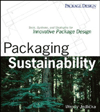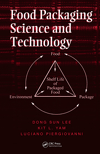PMMI Corner: Don't parrot, practice: Taking a holistic approach to sustainable packaging
Trends in machine innovation will impact
sustainability in 2012 and beyond.
 To view this article in the digital edition,
click here and turn to page 17.
To view this article in the digital edition,
click here and turn to page 17.
With every year that passes, manufacturers face increased pressure to demonstrate sustainable practices on a global scale. Increasing demand from consumers, retailers, brand owners and industry regulators has shifted the focus on sustainability from materials and the “final package” to considering the impact of total systems on waste and energy reduction across the supply chain.
PMMI’s report “PACK EXPO Las Vegas 2011: Upbeat and Setting Records,” indicates an increased role for machinery in sustainability considerations. Exhibitors and their customers focused largely on energy savings, waste minimization and solving handling problems related to adoption of source‐reduced materials/containers.
Common themes included “streamlining operations,” “minimizing operational costs,” “total cost of ownership,” “reducing downtime, changeover time and labor,” “lowering utility usage (water, compressed air and electricity),” and “increasing throughput”. All of these descriptors point to a sustainable footprint in the manufacturing environment and ultimately, the need for innovative machinery technology.
Challenges
Taking a total systems approach to sustainability is not without challenge. Manufacturers are charged with finding new machinery solutions or retrofitting existing machinery to accommodate new, thinner materials, while maintaining efficiency and minimizing downtime.
Meanwhile, brand owners must ensure the aesthetics and performance of their new, sustainable package design are not compromised or distorted in any way during the manufacturing process to keep consumer loyalty intact. Undoubtedly, as sustainable materials and technology continue to develop, so must packaging machinery to meet the needs of these new packages.
Spotlight on Innovation
Fortunately, there are many new machinery solutions on the market that address the concerns of both manufacturers and brand owners in implementing sustainable package design.
A major trend cited in PMMI’s PACK EXPO 2011 post-show report is the rising number of machines that are engineered for ease of use, incorporating technologies such as Human Machine Interface (HMI) panels. These panels can enhance efficiency by minimizing operations downtime. For example, ABB Robotics (www.abb.com/robotics) displayed a four-axis IRB460 palletizing robot at PACK EXPO 2011 featuring Palletizing PowerPac software, which simplifies programming, particularly for personnel with limited experience with robots. After the software simulates the task the robot should perform, the routine is downloaded to the controller, enhancing efficiency and ultimately, sustainability. These machines are also engineered to be lighter and less bulky, so they fit better at the end of the packaging line. Reducing size and weight shortens travel distances, increases speed and reduces power consumption.
Developments in vacuum technology can also contribute to sustainability during the manufacturing process. Pneumatics demonstrations, using less air were prevalent at PACK EXPO 2011. Energy efficient pumps allow manufacturers to reduce energy use in the plant and maximize efficiency.
As the spotlight on sustainability continues, manufacturers and brand owners will undoubtedly continue to evaluate machinery technology across the supply chain to provide products with a sustainable footprint and to maximize efficiency of the production operation.
Learn more about PMMI and the PACK EXPO trade shows at PMMI.org and Packexpo.com.
Tom Egan, Vice President, Industry Services, PMMI

With every year that passes, manufacturers face increased pressure to demonstrate sustainable practices on a global scale. Increasing demand from consumers, retailers, brand owners and industry regulators has shifted the focus on sustainability from materials and the “final package” to considering the impact of total systems on waste and energy reduction across the supply chain.
PMMI’s report “PACK EXPO Las Vegas 2011: Upbeat and Setting Records,” indicates an increased role for machinery in sustainability considerations. Exhibitors and their customers focused largely on energy savings, waste minimization and solving handling problems related to adoption of source‐reduced materials/containers.
Common themes included “streamlining operations,” “minimizing operational costs,” “total cost of ownership,” “reducing downtime, changeover time and labor,” “lowering utility usage (water, compressed air and electricity),” and “increasing throughput”. All of these descriptors point to a sustainable footprint in the manufacturing environment and ultimately, the need for innovative machinery technology.
Challenges
Taking a total systems approach to sustainability is not without challenge. Manufacturers are charged with finding new machinery solutions or retrofitting existing machinery to accommodate new, thinner materials, while maintaining efficiency and minimizing downtime.
Meanwhile, brand owners must ensure the aesthetics and performance of their new, sustainable package design are not compromised or distorted in any way during the manufacturing process to keep consumer loyalty intact. Undoubtedly, as sustainable materials and technology continue to develop, so must packaging machinery to meet the needs of these new packages.
Spotlight on Innovation
Fortunately, there are many new machinery solutions on the market that address the concerns of both manufacturers and brand owners in implementing sustainable package design.
A major trend cited in PMMI’s PACK EXPO 2011 post-show report is the rising number of machines that are engineered for ease of use, incorporating technologies such as Human Machine Interface (HMI) panels. These panels can enhance efficiency by minimizing operations downtime. For example, ABB Robotics (www.abb.com/robotics) displayed a four-axis IRB460 palletizing robot at PACK EXPO 2011 featuring Palletizing PowerPac software, which simplifies programming, particularly for personnel with limited experience with robots. After the software simulates the task the robot should perform, the routine is downloaded to the controller, enhancing efficiency and ultimately, sustainability. These machines are also engineered to be lighter and less bulky, so they fit better at the end of the packaging line. Reducing size and weight shortens travel distances, increases speed and reduces power consumption.
Developments in vacuum technology can also contribute to sustainability during the manufacturing process. Pneumatics demonstrations, using less air were prevalent at PACK EXPO 2011. Energy efficient pumps allow manufacturers to reduce energy use in the plant and maximize efficiency.
As the spotlight on sustainability continues, manufacturers and brand owners will undoubtedly continue to evaluate machinery technology across the supply chain to provide products with a sustainable footprint and to maximize efficiency of the production operation.
Learn more about PMMI and the PACK EXPO trade shows at PMMI.org and Packexpo.com.
Tom Egan, Vice President, Industry Services, PMMI
Looking for a reprint of this article?
From high-res PDFs to custom plaques, order your copy today!







